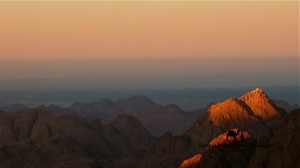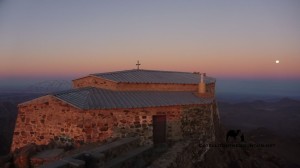February 2, 2015
Five holy peaks of the Sinai
 Mount Sinai is the spot they say God spoke with Moses, giving the 10 Commandments. It’s the Sinai’s holiest peak. You could make a good case for it being the holiest in the world too. Holier to more people, in more parts of the world, over a longer time, than any other mountain on earth – which is really something. It isn’t the Sinai’s only holy peak though. There are plenty of others. Some of them are holy because – like Mount Sinai – they’re on the Biblical map. Others, because of later miracles. And some were holy in much more distant eras, to much earlier peoples of the peninsula, whose religions we know little about today. Here are five holy peaks of the Sinai you rarely hear about:
Mount Sinai is the spot they say God spoke with Moses, giving the 10 Commandments. It’s the Sinai’s holiest peak. You could make a good case for it being the holiest in the world too. Holier to more people, in more parts of the world, over a longer time, than any other mountain on earth – which is really something. It isn’t the Sinai’s only holy peak though. There are plenty of others. Some of them are holy because – like Mount Sinai – they’re on the Biblical map. Others, because of later miracles. And some were holy in much more distant eras, to much earlier peoples of the peninsula, whose religions we know little about today. Here are five holy peaks of the Sinai you rarely hear about:
1. JEBEL SERBAL Jebel Serbal looks amazing. If you had to say any peak in the Sinai was holy based on looks alone, it’d probably be this. And for a long time, people did say it was holy. Some scholars reckon the name Serbal comes from ‘Baal’, a pagan God who was worshipped in these parts of the Middle East in ancient times. There’s a little ruin on the mountain top that dates from a later era, which archaeologists reckon was a Nabataean temple. Later still, in Christian times, Jebel Serbal took on a whole new association. Early Christians believed it was the real Mount Sinai of The Bible – i.e not the peak we call Mount Sinai today. The ruins of the Sinai’s first episcopal city, plus hermit cells, chapels and crumbling stairways, still stand around the mountain today.
 2. JEBEL KATHERINA Egypt’s highest peak. Legend has it angels carried the body of St Katherine here after the Romans killed her in Alexandria. The exact whereabouts of her bones remained unknown until one day in the 9th century when, claiming all had been revealed in a God-given dream, a local monk wandered up the mountain and found them on this summit (the lower of the mountain’s two high points and the second highest point in Egypt 2637m). Ever since then, this peak has been hallowed ground. There’s a small chapel on top but the bones of St Katherine are now in the Monastery of St Katherine.
2. JEBEL KATHERINA Egypt’s highest peak. Legend has it angels carried the body of St Katherine here after the Romans killed her in Alexandria. The exact whereabouts of her bones remained unknown until one day in the 9th century when, claiming all had been revealed in a God-given dream, a local monk wandered up the mountain and found them on this summit (the lower of the mountain’s two high points and the second highest point in Egypt 2637m). Ever since then, this peak has been hallowed ground. There’s a small chapel on top but the bones of St Katherine are now in the Monastery of St Katherine.
3. JEBEL TAHUNA A little peak in Wadi Feiran, local legend has it Jebel Tahuna is the spot where Moses watched the Battle of Rephidim, raising his magic staff to spur the Israelites on to victory. A 1500 year oratory crowns the summit, with a near-perfectly preserved water cistern dug into its foundations. Small chapels, whose walls, columns and altars are all still visible, stand by the path up the mountain. Hermit cells are dug into banks along its lower slopes and the higher hillsides are scattered with ancient Christian tombs. Travellers have been climbing this peak for centuries, and you should too. As much as the history, it’s worth it for the beautiful views you get over Wadi Feiran – one of the Sinai’s biggest, most beautiful wadis – and of Jebel Serbal, towering up like a castle.
 4. JEBEL MONEJA A lot of tourists climb this, making the mistake of thinking it’s Mount Sinai. Actually, it’s just a smaller, sister peak, half way up. It’s also called Jethro’s Mountain, after Jethro, the Biblical figure, whose daughter is supposed to have married Moses. Monks say God spoke to Moses here, beckoning him further up the mountain, and it’s another of the Sinai’s holiest spots. With a chapel on top, this is a brilliant peak with what is – in my opinion – the best view of the Monastery of St Katherine in the Sinai; the classic viewpoint from which artists sketched it, huddling below Mount Sinai, for centuries.
4. JEBEL MONEJA A lot of tourists climb this, making the mistake of thinking it’s Mount Sinai. Actually, it’s just a smaller, sister peak, half way up. It’s also called Jethro’s Mountain, after Jethro, the Biblical figure, whose daughter is supposed to have married Moses. Monks say God spoke to Moses here, beckoning him further up the mountain, and it’s another of the Sinai’s holiest spots. With a chapel on top, this is a brilliant peak with what is – in my opinion – the best view of the Monastery of St Katherine in the Sinai; the classic viewpoint from which artists sketched it, huddling below Mount Sinai, for centuries.
5. JEBEL EL AHMAR Sometimes also known as Jebel Moneja – like the peak above – this is a little-known summit in the northern foothills of Jebel Serbal. It isn’t as dramatic-looking as the other peaks here, but all the same, this was one of the Sinai’s holiest summits for a long time. Early explorers recorded it having a special place for the local Bedouin of Wadi Feiran. They’d make pilgrimage trips to a shrine on the top, tying rags, beads, camel reigns and other offerings to the stones. That’s stopped today, but I’ve still heard people talk about it in the past. If you go you’ll have a spectacular view over Wadi Feiran, with its big palm grove; and one of the best views of Jebel Serbal. You can also visit the tomb of Sheikh Shebib, a holy saint of the Gararsha tribe, at the foot of the peak.